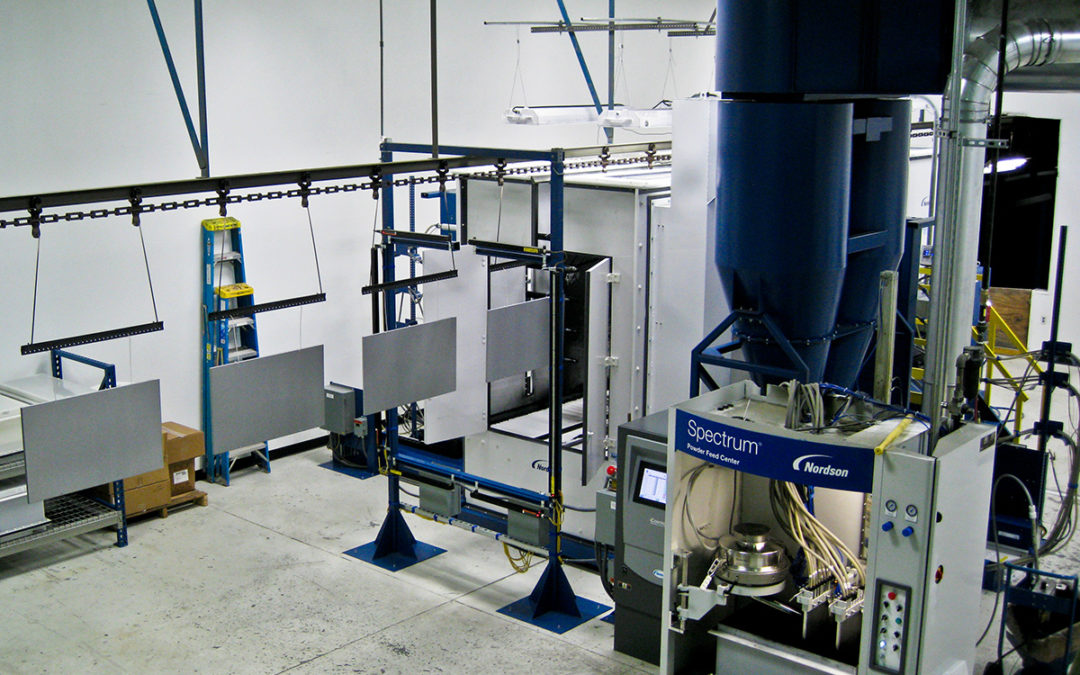After its inception in the 1950s, powder coating has gained popularity in the manufacturing community thanks to its efficiency and durable finish. But, can it really be better than tried-and-true traditional paint?
Powder Coating Process
Before we compare these two techniques, let’s look at how the powder coating process works.
Powder coating is, essentially, the electrostatic application of powder to metal parts that are then heated – commonly referred to as baked – to ensure a hard, continuous coating.
Powder coating begins with a pre-treatment and a surface preparation of the metal part that is to be “painted.” Each part is cleaned, removing anything that might interfere with the powder coating process (grease, dirt, etc.).
Once the metal is pre-treated and air-dried, it receives a high voltage electrostatic surge and is then covered with powder. This powder can be applied either through fluidized-bed – a process best for coating large irregular items such as dishwasher baskets or pipe fittings that involves a specialized process of dipping the items into a fluid bed with the powder coating – or spray techniques.
The powder is electrically charged, which allows for each particle to have a negative charge. This negatively-charged powder is attracted to your electrically-grounded part and allows for an even attachment and finish.
Next, the product is placed in the oven. Once the powder turns to gel and eventually cures, it’s removed from the oven, allowed to cool and ready to be put to work.
So, is powder coating the right choice for your needs?
When deciding between powder coating and traditional painting, it’s important to understand what methods work best for the types of material you have and for your desired outcome. Let’s look at the advantages and disadvantages of each technique.
Advantages of Powder Coating
Durable and Strong
Powder coating has a very thick finish, making it extremely durable against imperfections such as chips, corrosions, scratches or damage from road debris. It also allows for customization in texture and colored finishes.
One and Done
Powder coating sets all at once and does not need a second or third coat like traditional wet paint, which means an even, no-drip finish the first time. Powder coating will also keep a more vibrant color much longer than traditional paint.
Environmentally Friendly
Liquid paint jobs are comparatively more hazardous than powder coating jobs. While liquid paint often contains harmful solvents or volatile organic compounds (VOCs) that require preventative safety measures for breathing and specific disposal, powder coating contains little to no VOCs and can be easily disposed of.
Efficiency is Key
Traditional paint jobs can take days for your product to air dry, but with powder coating, your product is cured and ready for use in under 30 minutes.
This means if you’ve got a larger project on your hands, powder coating is the economical choice.
Plus, since this technique uses powder and not liquid, any excess product can be reclaimed after each job, meaning less powder/product waste.
Disadvantages of Powder Coating
No Thin Finish
Powder coating is known for its durable, strong finish, which means it’s not ideal for any project that requires a thinner, more delicate finish.
Difficult to Touch-Up
Touch-ups for powder-coated products are more time-consuming than traditionally-painted projects and can sometimes require more work than a quick dab with a paintbrush. Luckily, powder coating is more durable than traditional paint jobs and needs to be touched up less.
Heavy Initial Costs
If you’re thinking about purchasing supplies to powder coat products yourself, understand that you won’t feel the economic savings until after expensive initial start-up costs, which include buying the appropriate oven and application guns.
If you’re not planning to powder coat in-house daily, we recommend finding a reliable partner for your powder coating needs.
Advantages of Traditional Painting
Thinner Paint Jobs
Traditional painting allows you to be more precise. If you’re painting smaller products, or if you’re looking for a much thinner finish than powder coating provides (up to 15-20 micro-centimeters), then traditional painting is likely your best bet.
Endless Color Options
With traditional liquid paints, your choices for custom colors and finishes is infinite. Liquid paints can easily be mixed together to create the perfect shade. Powder coating certainly has a large range of color options, but not every brand may offer every color you’re looking for.
Doesn’t Require Heat
Traditional painting can be used for objects that won’t be able to withstand powder coating’s hot oven.
Disadvantages of Traditional Painting
Watching Paint Dry
As we’ve mentioned earlier, traditional liquid paint projects can take days to air dry properly, making it much less efficient than a powder-coated product, which will dry within 30 minutes.
Easily Scratched
Liquid paint is much less durable and more prone to chips, scratches and damage from things like road debris.
Safety and Environmental Concerns
Liquid paint has a harsh effect on the environment and can be toxic to humans if not handled properly. It is not only flammable but also has solvents and volatile organic compounds that make it hazardous. Using liquid paint requires protective breathing measures and must be disposed of carefully.
Which One Is The Winner?
So, which one is right for you?
As you can see, choosing between traditional painting and powder coating depends on the needs of your project. Both options can have a great result depending on the products you’re working with. If you’re in need of powder coating or want more information on if it’s the right fit for your product, give Highland Machine a call! We’ll be happy to help you through the process.
